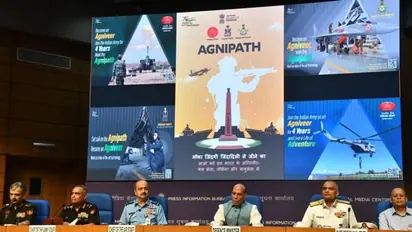NDA allies' concerns prompt Indian Army to review Agnipath scheme; recommendations proposed for Agniveers here

Synopsis
The Indian Army reviews the Agnipath scheme amid concerns from NDA partners, aiming to balance operational efficiency while addressing feedback on training, personnel shortages, and socio-cultural challenges.
New Delhi: With National Democratic Alliance (NDA) partners such as the Janata Dal (United) and the Lok Janshakti Party (Ram Vilas) expressing concerns over the Agnipath scheme and calling for its review once the government is formed, the Indian Army has been closely analyzing feedback from various formations across the country. This effort aims to ensure that the induction of Agniveers does not encounter functional issues and that the "operational efficiency" remains intact.
Sources within the defence and security establishment indicate that this study is being conducted not only at the force level but also through assessments by the defence ministry at the personnel level.
Among the recommendations, the force proposes increasing the percentage of Agniveers absorbed after completing four years of service from the current 25 percent to 60-70 percent. Additionally, they suggest extending the service tenure from 4 years to 7-8 years.
The recommendations were also made with regards to “raising induction age for Agniveers in technical trades up to 23 years, ex-gratia be sanctioned for disability developed during training, exit management to be done under a professional agency and subsistence allowance to family of Agniveer Killed in Action (KIA).”
It is important to mention that the Agnipath scheme was introduced to reduce the pension bill and create a more youthful profile for the force. However, sources have highlighted significant feedback, including concerns about insufficient on-the-job training, which is perceived as "leading to inexperience and lack of expertise.”
Sources indicate that the Indian Army will face a significant shortage of personnel below officer rank, which could take over a decade to reach the sanctioned strength. They suggest making adjustments to the Agnipath scheme to achieve both goals: reducing the pension bill and maintaining a youthful force profile, without compromising operational capabilities.
It is also pertinent to note that both adversaries—China on the northern border and Pakistan on the western border—are actively enhancing their synergy and joint operations.
“With a little tweak the issue of experience can be resolved,” the source said.
Discussing the old recruitment scheme, the source noted that personnel inducted under this system typically retired at the age of 35. Those who were promoted to Subedar Major retired at 52.
“They were experienced and fully trained in every operational skill and drill," the source noted.
The source further added that the four-year fixed service of Agniveers would lead to competition in an effort to prove one’s employability as a permanent soldier.
“It should be cohesive so that they can perform as a Unit," the official stated.
“When there is no cohesion, it will affect the anti-terror and anti-insurgency operations of the force. It will also impact the conventional operations for which the Army is raised,” the official added.
Regarding troop training, it used to extend for approximately 11 months, but it has now been shortened to six months.
During the intense election campaigns across the northern region of the country, the opposition has highlighted socio-cultural concerns faced by Agniveers. Families are hesitant to arrange marriages for their daughters with Agniveers.
There is also apprehension that if released Agniveers, trained in handling arms and explosives, cannot transition into other economic activities or find jobs, it may lead to concerns about a "militarised society" and and can be “amenable to exploitation” due to dissatisfaction.
The officer was of the view that it “can be managed if the Agniveer percentage is reduced between 30-40 per cent.”
Stay updated with the Breaking News Today and Latest News from across India and around the world. Get real-time updates, in-depth analysis, and comprehensive coverage of India News, World News, Indian Defence News, Kerala News, and Karnataka News. From politics to current affairs, follow every major story as it unfolds. Download the Asianet News Official App to stay informed anytime, anywhere.